|   Four Down, Three To GoAircraft Numbers Down…Saturday dawned gray and humid at EAA’s AirVenture Oshkosh 2000, with marginal-VFR ceilings and stiff breezes as a low pressure system milled about somewhere over the horizon. Overnight temperatures fell to no lower than the mid-60s, but by mid-afternoon the thermometer had reached into the 80s. Still, the campers, lucky souls with hotel rooms and day-trippers converged on Wittman Regional Airport for the first day of the weekend. While the low ceilings and widespread IFR conditions elsewhere in the country have affected traffic at the airport this year, the almost-genetic need to make the pilgrimage to AirVenture can’t be overcome by mere mortals. Indeed, at one point Friday, EAA officials were concerned they would run out of automobile parking space and considering diverting incoming traffic to an off-site land parcel. This despite numbers from the OSH air traffic control tower that show aircraft movements are down about 50 percent against last year. …But Pedestrian Traffic Heavy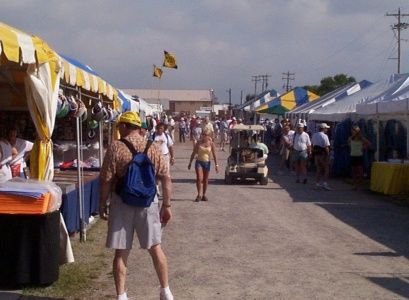 While obvious gaps were present in the general aviation parking and camping areas, all the people on the ramps, in the exhibit hangars and in the Fly Market had gotten here somehow. And by the afternoon, the ceilings had abated enough to squeeze in just enough sunshine to make the afternoon’s airshow interesting. Vendors were busy, but happy, and traffic in most booths and tents was of the sort that you couldn’t get an immediate answer to a product-related question. The folks at Garmin International’s booth, among others, were five to 10 people deep from the aisle most of the day, and customers at parts and supply outlets like Wag-Aero and Aircraft Spruce and Specialties kept the credit card machines warm. While obvious gaps were present in the general aviation parking and camping areas, all the people on the ramps, in the exhibit hangars and in the Fly Market had gotten here somehow. And by the afternoon, the ceilings had abated enough to squeeze in just enough sunshine to make the afternoon’s airshow interesting. Vendors were busy, but happy, and traffic in most booths and tents was of the sort that you couldn’t get an immediate answer to a product-related question. The folks at Garmin International’s booth, among others, were five to 10 people deep from the aisle most of the day, and customers at parts and supply outlets like Wag-Aero and Aircraft Spruce and Specialties kept the credit card machines warm.
Meanwhile, those who are safety-wired into being at AirVenture for the duration were looking fondly over their shoulders at the previous four days then turning to face optimistically the next three as they realized they were more than half-finished with the week-long event. Of particular interest, those who cared were looking forward to Sunday’s "Meet The Administrator" session with the FAA’s Jane Garvey. Her one-on-one question and answer sessions have always marked something of an activity peak during AirVenture and there’s usually something new or useful to come out of them. This year should be no different. And so it went at AirVenture 2000 on Saturday.
Bohannon Vows To Return, Fight Another Day…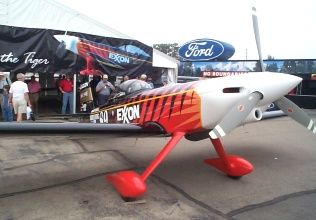 The anticipation is the worst… just ask Exxon Flyin’ Tiger pilot Bruce Bohannon. Yesterday morning at EAA AirVenture, Bohannon and his souped-up bird sat on the runway for three hours waiting for enough blue sky to safely launch. It never came. Though the plane and its pilot can fly IFR, doing so for a time-to-climb record over the very crowded skies of Oshkosh seemed a foolish risk to take. The Tiger has been known to shell an engine, and when dead-sticking, it is always preferable to be able to see the runway for which one is aiming. There was also the issue of a lot of other planes in the sky. "I didn’t want to be coming down in the midst of all that aluminum leaving to go other places," Bohannon said. The anticipation is the worst… just ask Exxon Flyin’ Tiger pilot Bruce Bohannon. Yesterday morning at EAA AirVenture, Bohannon and his souped-up bird sat on the runway for three hours waiting for enough blue sky to safely launch. It never came. Though the plane and its pilot can fly IFR, doing so for a time-to-climb record over the very crowded skies of Oshkosh seemed a foolish risk to take. The Tiger has been known to shell an engine, and when dead-sticking, it is always preferable to be able to see the runway for which one is aiming. There was also the issue of a lot of other planes in the sky. "I didn’t want to be coming down in the midst of all that aluminum leaving to go other places," Bohannon said.
There’s no doubt Bohannon is itching to tackle the 6,000-meter record. His last successful record attempt was last year at Oshkosh, when he eked out a win at 3,000 meters. Two other attempts since then have been unsuccessful. "The year since then has been long, hard and cold," Bohannon told AVweb. His attempt at this year’s Sun ‘n Fun ended soon after takeoff when he overleaned the engine and the complex nitrous-oxide system tanked the engine — hard. That engine, according to Bohannon, "is anchoring a boat in New York harbor. That’s about all it’s good for now." …Good-bye Nitrous, Hello Record…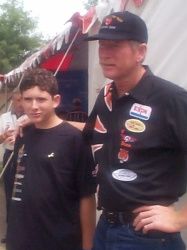 Bohannon is much more confident about his Oshkosh run, and not only because of his success last year. Mattituck came to see him after the SnF shelling and asked what they could do to help him get over the hump. "Make me an engine with more horsepower so I don’t need the nitrous," was his reply. That was exactly what he got. As South Park’s Cartman would say, Flyin’ Tiger’s new Mattituck IO-555 is ‘sweet.’ Very sweet. The IO-555 is a modified 540, with 555 cubic inches putting out 325 hp instead of the stock 260 hp. Without the nitrous, the plane is also 100 pounds lighter. Bohannon is much more confident about his Oshkosh run, and not only because of his success last year. Mattituck came to see him after the SnF shelling and asked what they could do to help him get over the hump. "Make me an engine with more horsepower so I don’t need the nitrous," was his reply. That was exactly what he got. As South Park’s Cartman would say, Flyin’ Tiger’s new Mattituck IO-555 is ‘sweet.’ Very sweet. The IO-555 is a modified 540, with 555 cubic inches putting out 325 hp instead of the stock 260 hp. Without the nitrous, the plane is also 100 pounds lighter.
Bohannon has been able to fly the engine 50 to 60 hours so far, sometimes taking three to four test flights per day. With the old nitrous-boosted engine, flights could only be taken every two to three days. "It’s like getting to fly for a change instead of work," he said. …Targeting Two Records, Not OneHow confident is Bohannon in his new powerplant? "I can give you every assurance of getting two records here," he said. If the weather will clear, that is. If it does clear, Bohannon will shoot skyward at 9 a.m. CST this morning to try to capture the 6,000-meter record. Within 24 hours of landing, Bohannon plans to take off again, this time to take the 9,000-meter record. Bohannon is serious about leaving Oshkosh as a new record-holder. His son made a hat with "Revenge of the Tiger" written on it, but call it Bruce’s revenge, too. God willing and the engine don’t shell, Sunday morning, Oshkosh crowds will see another bit of history fall — and another piece being made.
Dear Ms. Garvey: It’s Safe To Come To AirVentureKeith Peshak Escorted Off The Property… In recent years, a "signature" event at the Meet The Administrator sessions has inevitably been the appearance of Keith Peshak, a quirky, self-styled perennial critic of anything FAA-related. His annual question at the sessions is always controversial and guaranteed to elicit "Who is that guy?" responses from the uninitiated. This year, however, it appears Ms. Garvey won’t have to deal with Keith — and the rest of us will be deprived of some decent-quality improvisational theatre. In recent years, a "signature" event at the Meet The Administrator sessions has inevitably been the appearance of Keith Peshak, a quirky, self-styled perennial critic of anything FAA-related. His annual question at the sessions is always controversial and guaranteed to elicit "Who is that guy?" responses from the uninitiated. This year, however, it appears Ms. Garvey won’t have to deal with Keith — and the rest of us will be deprived of some decent-quality improvisational theatre.
To set the stage, know that Keith Peshak is a youngish computer researcher and pilot who is adamant that a flaw in current transponder standards and technology has been known by the FAA for some time and that the agency and others who know about it are unwilling to fix the problem. He frequently cites an FAA study demonstrating that 96 percent of all transponders in the U.S. don’t work, one conducted a few years back. Of course, his premise is eroded a bit when we look at our transponders blinking away on the flight home and hear the wonderful words, "radar contact." His belief in this flaw has fueled heated debates on the Internet and led to innumerable hostile encounters with the FAA, not least of which occurs each year at — you guessed it — the "Meet The Administrator" session. Instead, it appears that AirVenture officials have had enough. …Amid Claims Of Inappropriate Language…At this year’s AirVenture, Peshak scheduled three forum events; one on how to convert a palm-sized computer into a GPS-driven moving map, one entitled, "Yearly GPS Glonass Loran-C Update" and a third involving adding TCAS capability to a $200 GPS moving map. Instead, by late Friday night, he had been escorted off the event property and refunded his money. The "why" part is a little fuzzy, though. Some details aren’t in dispute: Both EAA and Peshak himself acknowledge that his presentations were profane. As for Peshak, he wrote in an email to AVweb and several others, "I don’t believe that I used any more or worse profanity than General Chuck Yeager used in his forum 7/28/2000 at 10:00 AM in the Eclipse Pavilion…." Exactly what Peshak said in his presentations is where the evidence trail breaks down. And frankly, we at AVweb wouldn’t be able to publish it, anyway. According to EAA, attendees complained about the inappropriateness of Peshak’s comments during his presentations; many others expressed their displeasure simply by walking out. Sometime after that, Peshak was shown the door. Neither party even hints that Peshak’s departure was anything but peaceable and the EAA — if not Peshak — essentially considers the matter closed. Peshak’s email carried the story further, however, by adding that EAA has told him "that my association, now and in the future, with EAA is terminated." However, EAA tells AVweb that Peshak remained a member of the association, at least as of Saturday afternoon. …So Stay Tuned For The Next Episode Of This Soap OperaWhat, if anything, will be included in the next installment of "The Annual Peshak Vs. The FAA Show" is anyone’s guess. And whether the EAA will now become an object for Peshak’s emailed scorn is also — dare we say it? — up in the air. Of course, there’s always the question of whether our antagonist will simply buy a general admission ticket and stroll in unannounced and unexpected. But, for now anyway, it appears Ms. Garvey’s annual performance before the EAA’s rank-and-file will be without at least one traditional scene. And, at least from an entertainment standpoint, the Administrator’s gain is our loss. Check back with AVweb tomorrow: Same bat-time, same bat-channel. NOTE: AVweb’s coverage includes the complete text of Keith Peshak’s email to AVweb in the aftermath of his being escorted off the EAA AirVenture grounds.
GlasStar And Glasair Owners Have No One Else To Look To…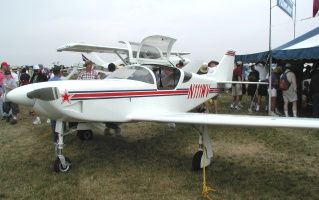 GlasPlanes President Lonny Weitzel announced Friday that as much as possible, his company wants to step into the vacuum left by the Chapter 11 bankruptcy of Stoddard-Hamilton (S-H), which until May was the manufacturer of Glasair and GlaStar kitplanes. At a banquet for owners and debtors of S-H on Wednesday, and again at a news conference on Friday, he made it clear he would like to pick up right where S-H left off, including the same factory, staff, phone numbers, and relationships with suppliers. What the new company will not preserve is the debt, obligations, or previous management of S-H. Weitzel made the analogy, "Just like an airplane, Stoddard-Hamilton went into a stall and a spin. I don’t have much insight into why that happened, but we do want to pull up and make a recovery at a low altitude before it’s too late." GlasPlanes President Lonny Weitzel announced Friday that as much as possible, his company wants to step into the vacuum left by the Chapter 11 bankruptcy of Stoddard-Hamilton (S-H), which until May was the manufacturer of Glasair and GlaStar kitplanes. At a banquet for owners and debtors of S-H on Wednesday, and again at a news conference on Friday, he made it clear he would like to pick up right where S-H left off, including the same factory, staff, phone numbers, and relationships with suppliers. What the new company will not preserve is the debt, obligations, or previous management of S-H. Weitzel made the analogy, "Just like an airplane, Stoddard-Hamilton went into a stall and a spin. I don’t have much insight into why that happened, but we do want to pull up and make a recovery at a low altitude before it’s too late."
The Glasair line has a 21-year history, and over 1,700 kits have been delivered. Over 800 of the GlaStar model have been delivered. Weitzel vowed to "answer the phone" and continue to support planes in the field. He vowed that all deposits and kit purchase money would be held in escrow until the kit is shipped. More problematic is when that will happen, and what becomes of the S-H customers holding IOUs for parts already paid for. …While Everyone’s Waiting On The Judge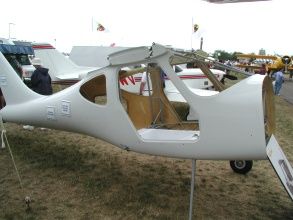 Weitzel said, "We had hoped to have the official approval of the bankruptcy court to purchase the assets of Stoddard-Hamilton by this week, but that hearing has been delayed until August 11." Until the bankruptcy court gives its official okay, everything is in limbo. Weitzel made a plea for anyone who might be interested in purchasing the company to step up now rather than later, to avoid delaying the process further. GlasPlanes has already inked an agreement with Arlington Aircraft Development, the company that owns the design rights and tooling for the GlaStar, to manufacture, market and support the GlaStar just as S-H had been doing. The rights to the Glasair will come with the S-H asset purchase. "If the purchase goes through as scheduled, we will be shipping parts within 30 days, and kits within 60 days," Weitzel promised. Weitzel said, "We had hoped to have the official approval of the bankruptcy court to purchase the assets of Stoddard-Hamilton by this week, but that hearing has been delayed until August 11." Until the bankruptcy court gives its official okay, everything is in limbo. Weitzel made a plea for anyone who might be interested in purchasing the company to step up now rather than later, to avoid delaying the process further. GlasPlanes has already inked an agreement with Arlington Aircraft Development, the company that owns the design rights and tooling for the GlaStar, to manufacture, market and support the GlaStar just as S-H had been doing. The rights to the Glasair will come with the S-H asset purchase. "If the purchase goes through as scheduled, we will be shipping parts within 30 days, and kits within 60 days," Weitzel promised.
The knotty problem of builders left holding the bag when S-H folded was clearly an uncomfortable topic for Weitzel, but the hard-nosed legal answer is that GlasPlanes does not "owe" them anything. Some hope comes from benefit funds that will be established by both the GlaStar Association International and the Glasair News group. Weitzel promised to contribute matching funds to these associations, up to 1 percent of first-year sales. Weitzel also said that any owner who lost their kit purchase money with S-H will get a 20-percent discount off a kit with GlasPlanes, if they help sell an additional kit to someone else.
Here’s Your Flying Car!…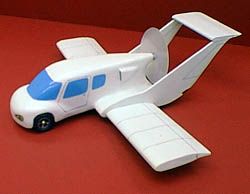 You can’t buy one yet, but the winner of this year’s NASA and FAA National General Aviation Design Competition is a plane that the design team calls "roadable"— it can both fly and drive. The first-place award was presented yesterday to a team made up of students from Virginia Tech in Blacksburg, Va., and Loughborough University in Leicestershire, England. The 28-person team named their entry Pegasus, and it presented them with the challenge of how to provide good performance in the air, along with adequate performance on the road as a secondary feature. They had to meet safety and operational regulations for both aircraft and automobiles. You can’t buy one yet, but the winner of this year’s NASA and FAA National General Aviation Design Competition is a plane that the design team calls "roadable"— it can both fly and drive. The first-place award was presented yesterday to a team made up of students from Virginia Tech in Blacksburg, Va., and Loughborough University in Leicestershire, England. The 28-person team named their entry Pegasus, and it presented them with the challenge of how to provide good performance in the air, along with adequate performance on the road as a secondary feature. They had to meet safety and operational regulations for both aircraft and automobiles.
"We spent about four months working hard on the final design," said University of Leicestershire student James Birtwhistle. "There were 12 of us in England, and we only had about five working days where both teams were in the same place." The rest of the time the collaboration was done long-distance. Wind-tunnel testing for the design was done at Virginia Tech. The winners take home $5,000 for Virginia Tech and $3,000 for team members. The overall competition is sponsored by NASA Langley’s Advanced General Aviation Transport Experiments (AGATE) program, and is managed for NASA and the FAA by the Virginia Space Grant Consortium. …Or Would You Rather Have No Landing Gear?…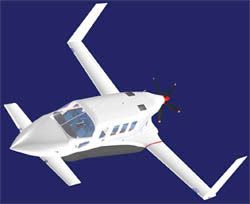 The second-place prize went to a team from Purdue University, West Lafayette, Ind., for their Silairus 490. The six-passenger piston design features an air-cushion landing system in place of traditional landing gear, for surface-independent takeoffs and landings. This aspect also won the U.S. Air Force’s Best Use of Air-Force-Developed Technology award. The Purdue team netted $2,000 for second place and $3,000 for the USAF prize. The second-place prize went to a team from Purdue University, West Lafayette, Ind., for their Silairus 490. The six-passenger piston design features an air-cushion landing system in place of traditional landing gear, for surface-independent takeoffs and landings. This aspect also won the U.S. Air Force’s Best Use of Air-Force-Developed Technology award. The Purdue team netted $2,000 for second place and $3,000 for the USAF prize.
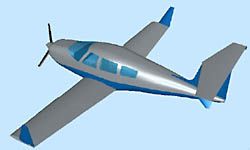 Third place and $1,000 went to the Alnighter, developed by a team from Pennsylvania State University. It’s a composite six-seater with advanced systems and avionics. The AOPA Air Safety Foundation also awarded $500 for its Best Retrofit Design to a team from the University of Oklahoma for its innovative multi-mode tuned exhaust system. The design not only reduced noise; it also increased the test plane’s top speed. Third place and $1,000 went to the Alnighter, developed by a team from Pennsylvania State University. It’s a composite six-seater with advanced systems and avionics. The AOPA Air Safety Foundation also awarded $500 for its Best Retrofit Design to a team from the University of Oklahoma for its innovative multi-mode tuned exhaust system. The design not only reduced noise; it also increased the test plane’s top speed.
…Or A Safer Seat?The University of Oklahoma also won the Design It, Build It, Fly It segment of the competition for their work on a safer, more crashworthy seat for older aircraft. A previous "Best Retrofit" award winner, the Sooners were awarded a $10,000 grant to take their energy-absorbing seat to the proof-of-concept stage. The seat pan is made of carbon steel that has been slit and expanded to provide a strong but impact-absorbing mesh.
STEMME USA Announces New Motorglider, Pure Sailplane…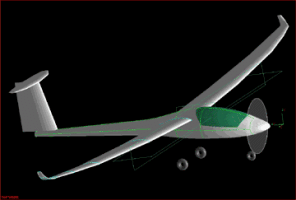 STEMME USA — North American distributors of the Rolls-Royce of motorgliders, the STEMME S10-VT — announced at AirVenture 2000 that they are adding two more aircraft to their product line. The S08 motorglider and the S07 Sport Glider offer two less-expensive alternatives to glider pilots who liked the performance and flexibility of the S10, but couldn’t afford the $170,000-plus price tag. Both new models are being designed and manufactured by STEMME GmbH & Company of Germany. The S08 will not have a retractable propeller or undercarriage like the S10, but will still offer side-by-side seating and a glide ratio of 35-to-1 with the propeller feathered. These simplified design features, plus a shorter wing span, should result in a price almost $70,000 less than the S10. The S07 pure sailplane is geared toward the training market, and the side-by-side seating should be a selling advantage for students who like to have their instructor beside them instead of behind them. STEMME is calculating a glide ratio of 45-to-1, and will offer wing-tip extensions to extend the 18-meter wingspan an additional two meters for even better performance. First flight for both ships is set for 2001, with deliveries expected two years later. Right now it looks like the S07 will set you back about $70,000, so start saving your pennies now. STEMME USA — North American distributors of the Rolls-Royce of motorgliders, the STEMME S10-VT — announced at AirVenture 2000 that they are adding two more aircraft to their product line. The S08 motorglider and the S07 Sport Glider offer two less-expensive alternatives to glider pilots who liked the performance and flexibility of the S10, but couldn’t afford the $170,000-plus price tag. Both new models are being designed and manufactured by STEMME GmbH & Company of Germany. The S08 will not have a retractable propeller or undercarriage like the S10, but will still offer side-by-side seating and a glide ratio of 35-to-1 with the propeller feathered. These simplified design features, plus a shorter wing span, should result in a price almost $70,000 less than the S10. The S07 pure sailplane is geared toward the training market, and the side-by-side seating should be a selling advantage for students who like to have their instructor beside them instead of behind them. STEMME is calculating a glide ratio of 45-to-1, and will offer wing-tip extensions to extend the 18-meter wingspan an additional two meters for even better performance. First flight for both ships is set for 2001, with deliveries expected two years later. Right now it looks like the S07 will set you back about $70,000, so start saving your pennies now.
…And From Italy, A Motorglider For The Masses Many sailplane pilots would love to cut the rope, so to speak, of being towed into the air to soar like the hawk, but unfortunately the price of most motorgliders is out of reach for the average soaring pilot. But that could change with the introduction into the U.S. of the Alisport Silent-IN motorglider. Silent Alisport LLC was showing their Silent-IN self-launching sailplane at AirVenture 2000 and gathering quite a few lookers around the sleek little composite bird. The Silent-IN has a 39.4-foot wingspan, 375-pound empty weight and comes with a Zanzottera 28-hp engine that retracts into the aft fuselage after self-launching. Another unique feature is the single-blade prop on the engine, which offers more efficient thrust and makes it easier to stow for soaring flight. Alisport said the Silent-IN has a maximum lift-to-drag ratio of 31-to-1, which has been proven in flight. Currently the little motorglider is only available in kit form for $29,500 and has an estimated build time of 500 hours. For sailplane purists, Alisport also offers the Silent sailplane without motor at $19,000 in kit form. Alisport said they have over 30 Silent series gliders flying in Europe, and hope to repeat their sales success in the U.S. For more information on the Silent, you can check out the Alisport web site. Many sailplane pilots would love to cut the rope, so to speak, of being towed into the air to soar like the hawk, but unfortunately the price of most motorgliders is out of reach for the average soaring pilot. But that could change with the introduction into the U.S. of the Alisport Silent-IN motorglider. Silent Alisport LLC was showing their Silent-IN self-launching sailplane at AirVenture 2000 and gathering quite a few lookers around the sleek little composite bird. The Silent-IN has a 39.4-foot wingspan, 375-pound empty weight and comes with a Zanzottera 28-hp engine that retracts into the aft fuselage after self-launching. Another unique feature is the single-blade prop on the engine, which offers more efficient thrust and makes it easier to stow for soaring flight. Alisport said the Silent-IN has a maximum lift-to-drag ratio of 31-to-1, which has been proven in flight. Currently the little motorglider is only available in kit form for $29,500 and has an estimated build time of 500 hours. For sailplane purists, Alisport also offers the Silent sailplane without motor at $19,000 in kit form. Alisport said they have over 30 Silent series gliders flying in Europe, and hope to repeat their sales success in the U.S. For more information on the Silent, you can check out the Alisport web site.
But Are Two Necessarily Better?…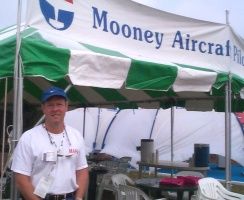 "It is absolutely a free country, and they have a right to do whatever they would like," Mooney Aircraft Pilots Association (MAPA) president Bob Kromer told AVweb regarding a new group called Mooney Owners of America (MOA). "But I just don’t think there are enough Mooney pilots to support two pilot groups." But, says Coy Jacob, MOA board member, "There are 7500 registered Mooney owners in the FAA database, and I think there is room for another organization." Time will ultimately tell who is right, but the bigger question is, what’s going on here? Think of Cessna aircraft and the Cessna Pilots Association (CPA)comes to mind, the same for Yankee owners and the American Yankee Association (AYA). The same had been true of Mooney pilots and MAPA. Until now. "It is absolutely a free country, and they have a right to do whatever they would like," Mooney Aircraft Pilots Association (MAPA) president Bob Kromer told AVweb regarding a new group called Mooney Owners of America (MOA). "But I just don’t think there are enough Mooney pilots to support two pilot groups." But, says Coy Jacob, MOA board member, "There are 7500 registered Mooney owners in the FAA database, and I think there is room for another organization." Time will ultimately tell who is right, but the bigger question is, what’s going on here? Think of Cessna aircraft and the Cessna Pilots Association (CPA)comes to mind, the same for Yankee owners and the American Yankee Association (AYA). The same had been true of Mooney pilots and MAPA. Until now.
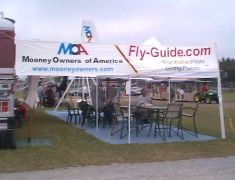 Chris Harrison, MOA’s members benefits coordinator, said the MOA, based in Nokomis, Fla., was needed to provide benefits for members that MAPA is not offering, such as a more comprehensive Web site and a database of Mooney Service Centers and airplane parts. MOA also plans to set up an arbitration board under which all advertisers to their Web site and magazine will have to agree to a formal complaint process. When a complaint from a Mooney pilot member comes in, for instance, MOA will forward it to the particular business or the Mooney factory for response. If the company remains unresponsive after a certain period of time, that lack of response would be written up on the Web site or published in the magazine. "It’s not to be adversarial," says Jacob. Chris Harrison, MOA’s members benefits coordinator, said the MOA, based in Nokomis, Fla., was needed to provide benefits for members that MAPA is not offering, such as a more comprehensive Web site and a database of Mooney Service Centers and airplane parts. MOA also plans to set up an arbitration board under which all advertisers to their Web site and magazine will have to agree to a formal complaint process. When a complaint from a Mooney pilot member comes in, for instance, MOA will forward it to the particular business or the Mooney factory for response. If the company remains unresponsive after a certain period of time, that lack of response would be written up on the Web site or published in the magazine. "It’s not to be adversarial," says Jacob.
…MAPA And MOA: Similar, But Different…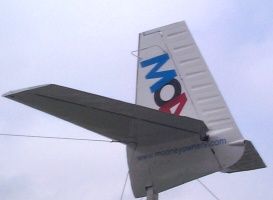 Harrison and Jacob took great pains to stress that MOA is not-for-profit and member-owned, and is beholden to no specific business or entity. On the flip side, they fear MAPA and the Mooney Aircraft Corporation (MAC) have gotten too close, which they worry is especially detrimental to owners of older Mooney models, who are seeing significantly less factory parts support. This despite a fairly well-known falling out between MAPA and the factory in April of 1999. Harrison and Jacob took great pains to stress that MOA is not-for-profit and member-owned, and is beholden to no specific business or entity. On the flip side, they fear MAPA and the Mooney Aircraft Corporation (MAC) have gotten too close, which they worry is especially detrimental to owners of older Mooney models, who are seeing significantly less factory parts support. This despite a fairly well-known falling out between MAPA and the factory in April of 1999.
We have a cooperative but distant relationship with the factory," MAPA’s Kromer told AVweb. "We don’t want to be an antagonist to the factory. I look at the some pilots’ associations and they’re not welcome at the factory. Their voice is not heard at the factory. Our voice is heard (at the Mooney factory). If you can’t get inside the factory doors, you have no power." Kromer is quick to credit MAC with recent attempts to improve customer service and other nagging problems, but is just as quick to say MAC must walk their talk. …Working Now For Mooney Owners’ Future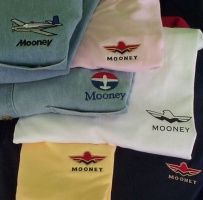 Kromer agrees that a big issue for many Mooney aircraft owners is keeping their pre-201 planes in the air, and the only way to do that is to have access to parts. "Mooney does support the "J" (201) models and up, and luckily many of the parts that fit the "J" fit the pre-201 models," says Kromer. "We’re okay right now, and I see us being okay for the next five years." After then? Kromer says MAPA will work to broker a deal between one or more of the "more sophisticated Service Centers" under which they would get tools and dies from MAC and begin producing the parts themselves. "We (MAC and MAPA) have talked about that briefly," Kromer says, "and they’ve not said ‘no.’ That’s why MAPA’s relationship must be one of cooperation. We can’t throw rocks. Our job is to support our members and we do. It’s in their best interests that we maintain communications with MAC." Kromer agrees that a big issue for many Mooney aircraft owners is keeping their pre-201 planes in the air, and the only way to do that is to have access to parts. "Mooney does support the "J" (201) models and up, and luckily many of the parts that fit the "J" fit the pre-201 models," says Kromer. "We’re okay right now, and I see us being okay for the next five years." After then? Kromer says MAPA will work to broker a deal between one or more of the "more sophisticated Service Centers" under which they would get tools and dies from MAC and begin producing the parts themselves. "We (MAC and MAPA) have talked about that briefly," Kromer says, "and they’ve not said ‘no.’ That’s why MAPA’s relationship must be one of cooperation. We can’t throw rocks. Our job is to support our members and we do. It’s in their best interests that we maintain communications with MAC."
"There are enough owners to support two groups," says MOA’s Jacob. "Maybe down the road, we’ll work together." For now at least, Mooney owners have two organizations from which to choose, or they can choose to support both… but whether two is better than one is a question still to be answered.
World Flight 2000 Team Getting Ready…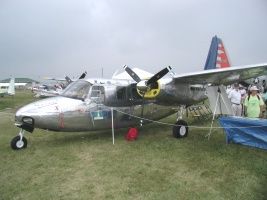 Those who haven’t been to AirVenture sometimes think of it as dominated by old guys sitting around hangar flying. There’s plenty of that, but without looking too hard there’s also a lot of youthful inspiration around. Right off Aeroshell Square, the World Flight 2000 team can be found with their AeroCommander 560E. Chris Wall and Dan Dominguez are two 21-year old pilots planning to depart September 1 on their attempt to become the youngest pilots to circumnavigate the world. Instead of trying to break speed records, the pair set up a foundation several years ago to fund the three-month flight, with an itinerary that helps them connect with children in classrooms throughout the world during their journey. They’re about $60,000 shy of the half-million dollars needed for the trip, but they and their friends have put the entire project together and aren’t going to let that stop them. Godspeed, guys! Those who haven’t been to AirVenture sometimes think of it as dominated by old guys sitting around hangar flying. There’s plenty of that, but without looking too hard there’s also a lot of youthful inspiration around. Right off Aeroshell Square, the World Flight 2000 team can be found with their AeroCommander 560E. Chris Wall and Dan Dominguez are two 21-year old pilots planning to depart September 1 on their attempt to become the youngest pilots to circumnavigate the world. Instead of trying to break speed records, the pair set up a foundation several years ago to fund the three-month flight, with an itinerary that helps them connect with children in classrooms throughout the world during their journey. They’re about $60,000 shy of the half-million dollars needed for the trip, but they and their friends have put the entire project together and aren’t going to let that stop them. Godspeed, guys!
NOTE: Learn more about World Flight 2000 at their web site. …While The Air Cadets From Canada Soak It All In…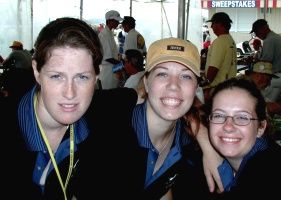 For 40 of the top Air Cadets/Cadets de l’Air from Canada, Oshkosh is the final stop on a two-week aviation tour of the U.S. (from Toronto through Dayton to Wisconsin). About 20,000 Canadian students between ages 12 and 19 compete each year for 500 coveted slots for airplane or glider training sponsored by the government. "At home we get to go on ‘bush weekends’ where we learn survival methods if your plane goes down in the woods," said cadet Sarah Fournier, "but coming to Oshkosh has been the best thing in aviation we’ve ever done." For 40 of the top Air Cadets/Cadets de l’Air from Canada, Oshkosh is the final stop on a two-week aviation tour of the U.S. (from Toronto through Dayton to Wisconsin). About 20,000 Canadian students between ages 12 and 19 compete each year for 500 coveted slots for airplane or glider training sponsored by the government. "At home we get to go on ‘bush weekends’ where we learn survival methods if your plane goes down in the woods," said cadet Sarah Fournier, "but coming to Oshkosh has been the best thing in aviation we’ve ever done."
…And One Very Young Eagle Gets Ready To Fly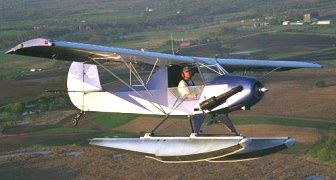 In a story that would make many kitbuilders envious, Brian Marx of Green Bay is here with a Sky Raider ultralight he built in less than three months. Brian is a 14-year-old honor student, and took delivery of his kit at Sun ‘n Fun 2000. Brian’s getting ready to take flight instruction, and although the Sky Raider looks like a "little airplane" he won’t have to wait until he’s 16 to solo. In a story that would make many kitbuilders envious, Brian Marx of Green Bay is here with a Sky Raider ultralight he built in less than three months. Brian is a 14-year-old honor student, and took delivery of his kit at Sun ‘n Fun 2000. Brian’s getting ready to take flight instruction, and although the Sky Raider looks like a "little airplane" he won’t have to wait until he’s 16 to solo.
Exxon Goes Elite — But You Can Still Buy Oil For Your Plane It’s not often you hear of oil being referred to as a baby, but ExxonMobil Global Aviation Manager Margaret Parnell is much like the proud mother. "It’s almost like being pregnant for six years," Parnell said yesterday at AirVenture. That’s how long it took to research, modify and test the Exxon Aviation Oil Elite, the first new aviation piston oil in 10 years. It’s not often you hear of oil being referred to as a baby, but ExxonMobil Global Aviation Manager Margaret Parnell is much like the proud mother. "It’s almost like being pregnant for six years," Parnell said yesterday at AirVenture. That’s how long it took to research, modify and test the Exxon Aviation Oil Elite, the first new aviation piston oil in 10 years.
The semi-synthetic 20W-50 Exxon Elite was first announced in April at Lakeland’s Sun ‘n Fun, but the company came to Oshkosh to give it a push. "Not only does the oil meet milspec, military approval, it’s also approved for O-320 and O-360 engines," said Exxon’s Stephen Sunseri. According to Sunseri, the new oil has been thoroughly flight-tested and promises better wear, corrosion control, and rust protection. Exxon has established a toll-free hotline at 888-22TIGER to answer questions, give out info and list distributors. In addition, the company has set up a new web site as a one-stop source for product information. A Revival Of The Classic Champ?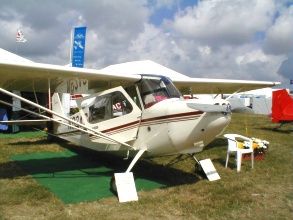 If American Champion Aircraft (ACA), manufacturer of the Citabria/Decathlon/Scout series of tandem taildraggers, gets enough interest, it’s a real possibility. And to generate that interest, ACA is showing a new Champ 7ACA at AirVenture 2000. The new Champ doesn’t look much different than the 1940s version that thousands of pilots learned to fly in. The only notable external difference is a sleeker cowl enclosing the Jabiru 80-hp engine and steel spring legs instead of the original bungee-chord type. Although the Champ displayed at AirVenture only had about six hours on it, ACA is predicting performance characteristics similar to the original. The company is projecting a price of $59,900 for a production version of the new Champ, and also is considering a quick-build kit that would be priced around $45,000. Currently ACA hasn’t committed to building the new Champ, and was asking people who may be interested in buying one to sign a list at AirVenture. Even if ACA does produce it, they want to keep it simple — no fancy paint or instruments and very few options. And for pilots who love to fly low and slow for fun, that’s the way it should be. If American Champion Aircraft (ACA), manufacturer of the Citabria/Decathlon/Scout series of tandem taildraggers, gets enough interest, it’s a real possibility. And to generate that interest, ACA is showing a new Champ 7ACA at AirVenture 2000. The new Champ doesn’t look much different than the 1940s version that thousands of pilots learned to fly in. The only notable external difference is a sleeker cowl enclosing the Jabiru 80-hp engine and steel spring legs instead of the original bungee-chord type. Although the Champ displayed at AirVenture only had about six hours on it, ACA is predicting performance characteristics similar to the original. The company is projecting a price of $59,900 for a production version of the new Champ, and also is considering a quick-build kit that would be priced around $45,000. Currently ACA hasn’t committed to building the new Champ, and was asking people who may be interested in buying one to sign a list at AirVenture. Even if ACA does produce it, they want to keep it simple — no fancy paint or instruments and very few options. And for pilots who love to fly low and slow for fun, that’s the way it should be.
Round The World, One Way Or Another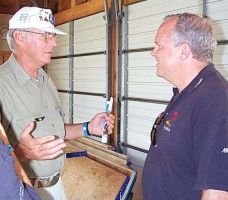 Piloting an airplane around the world is quite a trick no matter how you play it, and yesterday’s first-ever meeting of Earth-rounders, held here at AirVenture 2000, showed there are lots of different ways to pull it off. Dick Rutan did it nonstop on a single load of fuel — and got up to challenge his fellow flyers to a nonstop race. "I thought it would have happened by now," he said, "it’s been 14 years since Voyager." Jon Johanson is halfway round on his third RTW trip, having flown his homebuilt RV-4 from Adelaide, over the North Pole, and on to Oshkosh, landing here last Sunday after 150 hours of flying. "We’re not used to cold in Australia," Johanson said, "and the problems [crossing the Pole] began when the temperatures fell a lot lower than everyone said they would." He ran into a cold front about an hour south of the Pole, and was frozen numb straight through before finally reaching his next stop safely. Piloting an airplane around the world is quite a trick no matter how you play it, and yesterday’s first-ever meeting of Earth-rounders, held here at AirVenture 2000, showed there are lots of different ways to pull it off. Dick Rutan did it nonstop on a single load of fuel — and got up to challenge his fellow flyers to a nonstop race. "I thought it would have happened by now," he said, "it’s been 14 years since Voyager." Jon Johanson is halfway round on his third RTW trip, having flown his homebuilt RV-4 from Adelaide, over the North Pole, and on to Oshkosh, landing here last Sunday after 150 hours of flying. "We’re not used to cold in Australia," Johanson said, "and the problems [crossing the Pole] began when the temperatures fell a lot lower than everyone said they would." He ran into a cold front about an hour south of the Pole, and was frozen numb straight through before finally reaching his next stop safely.
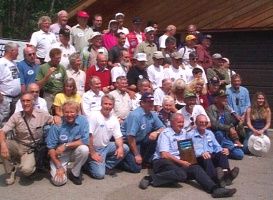 Everyone had a story to tell of the grand adventures they had circling the globe. Horst Ellenberger, of Germany, related a tale about ditching in the Pacific; Larry and Cathy Lee, of Atlanta, Ga., flew with their two sons — all four of them pilots — in a Piper Malibu in a RTW race back in 1992. "Larry said ‘You can take five pounds of baggage,’" Cathy Lee recalled, " and I told him, "You’ve got to be kidding. My shoes will weigh more than that!’" Gaby Kennard, of Australia, mortgaged her house and then went looking for sponsors to finance her 1989 trip in a Piper Saratoga, flying 29,000 nautical miles more or less following the route taken by Amelia Earhart. "It was an incredible dream," she said. "But if you can dream it, you can do it." Everyone had a story to tell of the grand adventures they had circling the globe. Horst Ellenberger, of Germany, related a tale about ditching in the Pacific; Larry and Cathy Lee, of Atlanta, Ga., flew with their two sons — all four of them pilots — in a Piper Malibu in a RTW race back in 1992. "Larry said ‘You can take five pounds of baggage,’" Cathy Lee recalled, " and I told him, "You’ve got to be kidding. My shoes will weigh more than that!’" Gaby Kennard, of Australia, mortgaged her house and then went looking for sponsors to finance her 1989 trip in a Piper Saratoga, flying 29,000 nautical miles more or less following the route taken by Amelia Earhart. "It was an incredible dream," she said. "But if you can dream it, you can do it."
Hans Gutmann, of Austria, invited all the Earth-rounders to a second gathering next year in Vienna. "It’s not that far away," he said. "Only 27 hours in my airplane." Weighed Down By Too Many Airplanes? Try Lighter Than Air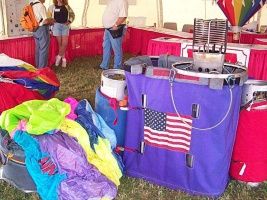 After a year’s absence, the Balloon Federation of America brought its exhibit back to EAA AirVenture this year, and according to Marlene Gaidzik, an Illinois balloonist, "There has been a lot of interest." Fixed-wing pilots are attracted to balloons, she said, because of their lower operating costs and the fact that you don’t need a medical certificate to fly them. "We find older pilots, who are looking for a change, are attracted to balloons, and so are younger pilots just starting out, who find it’s more affordable," she said. And you don’t have to buy a factory-built model, either — true to the spirit of the EAA, at center stage at the BFA exhibit is a homebuilt balloon, complete with its Experimental placard proudly displayed. After a year’s absence, the Balloon Federation of America brought its exhibit back to EAA AirVenture this year, and according to Marlene Gaidzik, an Illinois balloonist, "There has been a lot of interest." Fixed-wing pilots are attracted to balloons, she said, because of their lower operating costs and the fact that you don’t need a medical certificate to fly them. "We find older pilots, who are looking for a change, are attracted to balloons, and so are younger pilots just starting out, who find it’s more affordable," she said. And you don’t have to buy a factory-built model, either — true to the spirit of the EAA, at center stage at the BFA exhibit is a homebuilt balloon, complete with its Experimental placard proudly displayed.
|
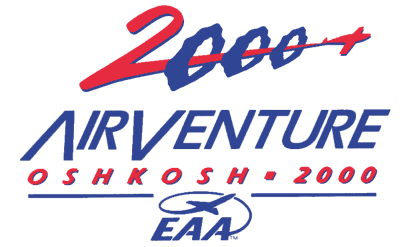



































 While obvious gaps were present in the general aviation parking and camping areas, all the people on the ramps, in the exhibit hangars and in the Fly Market had gotten here somehow. And by the afternoon, the ceilings had abated enough to squeeze in just enough sunshine to make the afternoon’s airshow interesting. Vendors were busy, but happy, and traffic in most booths and tents was of the sort that you couldn’t get an immediate answer to a product-related question. The folks at Garmin International’s booth, among others, were five to 10 people deep from the aisle most of the day, and customers at parts and supply outlets like Wag-Aero and Aircraft Spruce and Specialties kept the credit card machines warm.
While obvious gaps were present in the general aviation parking and camping areas, all the people on the ramps, in the exhibit hangars and in the Fly Market had gotten here somehow. And by the afternoon, the ceilings had abated enough to squeeze in just enough sunshine to make the afternoon’s airshow interesting. Vendors were busy, but happy, and traffic in most booths and tents was of the sort that you couldn’t get an immediate answer to a product-related question. The folks at Garmin International’s booth, among others, were five to 10 people deep from the aisle most of the day, and customers at parts and supply outlets like Wag-Aero and Aircraft Spruce and Specialties kept the credit card machines warm. The anticipation is the worst… just ask Exxon Flyin’ Tiger pilot Bruce Bohannon. Yesterday morning at EAA AirVenture, Bohannon and his souped-up bird sat on the runway for three hours waiting for enough blue sky to safely launch. It never came. Though the plane and its pilot can fly IFR, doing so for a time-to-climb record over the very crowded skies of Oshkosh seemed a foolish risk to take. The Tiger has been known to shell an engine, and when dead-sticking, it is always preferable to be able to see the runway for which one is aiming. There was also the issue of a lot of other planes in the sky. "I didn’t want to be coming down in the midst of all that aluminum leaving to go other places," Bohannon said.
The anticipation is the worst… just ask Exxon Flyin’ Tiger pilot Bruce Bohannon. Yesterday morning at EAA AirVenture, Bohannon and his souped-up bird sat on the runway for three hours waiting for enough blue sky to safely launch. It never came. Though the plane and its pilot can fly IFR, doing so for a time-to-climb record over the very crowded skies of Oshkosh seemed a foolish risk to take. The Tiger has been known to shell an engine, and when dead-sticking, it is always preferable to be able to see the runway for which one is aiming. There was also the issue of a lot of other planes in the sky. "I didn’t want to be coming down in the midst of all that aluminum leaving to go other places," Bohannon said. Bohannon is much more confident about his Oshkosh run, and not only because of his success last year. Mattituck came to see him after the SnF shelling and asked what they could do to help him get over the hump. "Make me an engine with more horsepower so I don’t need the nitrous," was his reply. That was exactly what he got. As South Park’s Cartman would say, Flyin’ Tiger’s new Mattituck IO-555 is ‘sweet.’ Very sweet. The IO-555 is a modified 540, with 555 cubic inches putting out 325 hp instead of the stock 260 hp. Without the nitrous, the plane is also 100 pounds lighter.
Bohannon is much more confident about his Oshkosh run, and not only because of his success last year. Mattituck came to see him after the SnF shelling and asked what they could do to help him get over the hump. "Make me an engine with more horsepower so I don’t need the nitrous," was his reply. That was exactly what he got. As South Park’s Cartman would say, Flyin’ Tiger’s new Mattituck IO-555 is ‘sweet.’ Very sweet. The IO-555 is a modified 540, with 555 cubic inches putting out 325 hp instead of the stock 260 hp. Without the nitrous, the plane is also 100 pounds lighter. In recent years, a "signature" event at the Meet The Administrator sessions has inevitably been the appearance of Keith Peshak, a quirky, self-styled perennial critic of anything FAA-related. His annual question at the sessions is always controversial and guaranteed to elicit "Who is that guy?" responses from the uninitiated. This year, however, it appears Ms. Garvey won’t have to deal with Keith — and the rest of us will be deprived of some decent-quality improvisational theatre.
In recent years, a "signature" event at the Meet The Administrator sessions has inevitably been the appearance of Keith Peshak, a quirky, self-styled perennial critic of anything FAA-related. His annual question at the sessions is always controversial and guaranteed to elicit "Who is that guy?" responses from the uninitiated. This year, however, it appears Ms. Garvey won’t have to deal with Keith — and the rest of us will be deprived of some decent-quality improvisational theatre. GlasPlanes President Lonny Weitzel announced Friday that as much as possible, his company wants to step into the vacuum left by the Chapter 11 bankruptcy of Stoddard-Hamilton (S-H), which until May was the manufacturer of Glasair and GlaStar kitplanes. At a banquet for owners and debtors of S-H on Wednesday, and again at a news conference on Friday, he made it clear he would like to pick up right where S-H left off, including the same factory, staff, phone numbers, and relationships with suppliers. What the new company will not preserve is the debt, obligations, or previous management of S-H. Weitzel made the analogy, "Just like an airplane, Stoddard-Hamilton went into a stall and a spin. I don’t have much insight into why that happened, but we do want to pull up and make a recovery at a low altitude before it’s too late."
GlasPlanes President Lonny Weitzel announced Friday that as much as possible, his company wants to step into the vacuum left by the Chapter 11 bankruptcy of Stoddard-Hamilton (S-H), which until May was the manufacturer of Glasair and GlaStar kitplanes. At a banquet for owners and debtors of S-H on Wednesday, and again at a news conference on Friday, he made it clear he would like to pick up right where S-H left off, including the same factory, staff, phone numbers, and relationships with suppliers. What the new company will not preserve is the debt, obligations, or previous management of S-H. Weitzel made the analogy, "Just like an airplane, Stoddard-Hamilton went into a stall and a spin. I don’t have much insight into why that happened, but we do want to pull up and make a recovery at a low altitude before it’s too late." Weitzel said, "We had hoped to have the official approval of the bankruptcy court to purchase the assets of Stoddard-Hamilton by this week, but that hearing has been delayed until August 11." Until the bankruptcy court gives its official okay, everything is in limbo. Weitzel made a plea for anyone who might be interested in purchasing the company to step up now rather than later, to avoid delaying the process further. GlasPlanes has already inked an agreement with Arlington Aircraft Development, the company that owns the design rights and tooling for the GlaStar, to manufacture, market and support the GlaStar just as S-H had been doing. The rights to the Glasair will come with the S-H asset purchase. "If the purchase goes through as scheduled, we will be shipping parts within 30 days, and kits within 60 days," Weitzel promised.
Weitzel said, "We had hoped to have the official approval of the bankruptcy court to purchase the assets of Stoddard-Hamilton by this week, but that hearing has been delayed until August 11." Until the bankruptcy court gives its official okay, everything is in limbo. Weitzel made a plea for anyone who might be interested in purchasing the company to step up now rather than later, to avoid delaying the process further. GlasPlanes has already inked an agreement with Arlington Aircraft Development, the company that owns the design rights and tooling for the GlaStar, to manufacture, market and support the GlaStar just as S-H had been doing. The rights to the Glasair will come with the S-H asset purchase. "If the purchase goes through as scheduled, we will be shipping parts within 30 days, and kits within 60 days," Weitzel promised. You can’t buy one yet, but the winner of this year’s NASA and FAA National General Aviation Design Competition is a plane that the design team calls "roadable"— it can both fly and drive. The first-place award was presented yesterday to a team made up of students from Virginia Tech in Blacksburg, Va., and Loughborough University in Leicestershire, England. The 28-person team named their entry Pegasus, and it presented them with the challenge of how to provide good performance in the air, along with adequate performance on the road as a secondary feature. They had to meet safety and operational regulations for both aircraft and automobiles.
You can’t buy one yet, but the winner of this year’s NASA and FAA National General Aviation Design Competition is a plane that the design team calls "roadable"— it can both fly and drive. The first-place award was presented yesterday to a team made up of students from Virginia Tech in Blacksburg, Va., and Loughborough University in Leicestershire, England. The 28-person team named their entry Pegasus, and it presented them with the challenge of how to provide good performance in the air, along with adequate performance on the road as a secondary feature. They had to meet safety and operational regulations for both aircraft and automobiles. The second-place prize went to a team from Purdue University, West Lafayette, Ind., for their Silairus 490. The six-passenger piston design features an air-cushion landing system in place of traditional landing gear, for surface-independent takeoffs and landings. This aspect also won the U.S. Air Force’s Best Use of Air-Force-Developed Technology award. The Purdue team netted $2,000 for second place and $3,000 for the USAF prize.
The second-place prize went to a team from Purdue University, West Lafayette, Ind., for their Silairus 490. The six-passenger piston design features an air-cushion landing system in place of traditional landing gear, for surface-independent takeoffs and landings. This aspect also won the U.S. Air Force’s Best Use of Air-Force-Developed Technology award. The Purdue team netted $2,000 for second place and $3,000 for the USAF prize. Third place and $1,000 went to the Alnighter, developed by a team from Pennsylvania State University. It’s a composite six-seater with advanced systems and avionics. The AOPA Air Safety Foundation also awarded $500 for its Best Retrofit Design to a team from the University of Oklahoma for its innovative multi-mode tuned exhaust system. The design not only reduced noise; it also increased the test plane’s top speed.
Third place and $1,000 went to the Alnighter, developed by a team from Pennsylvania State University. It’s a composite six-seater with advanced systems and avionics. The AOPA Air Safety Foundation also awarded $500 for its Best Retrofit Design to a team from the University of Oklahoma for its innovative multi-mode tuned exhaust system. The design not only reduced noise; it also increased the test plane’s top speed. STEMME USA — North American distributors of the Rolls-Royce of motorgliders, the STEMME S10-VT — announced at AirVenture 2000 that they are adding two more aircraft to their product line. The S08 motorglider and the S07 Sport Glider offer two less-expensive alternatives to glider pilots who liked the performance and flexibility of the S10, but couldn’t afford the $170,000-plus price tag. Both new models are being designed and manufactured by STEMME GmbH & Company of Germany. The S08 will not have a retractable propeller or undercarriage like the S10, but will still offer side-by-side seating and a glide ratio of 35-to-1 with the propeller feathered. These simplified design features, plus a shorter wing span, should result in a price almost $70,000 less than the S10. The S07 pure sailplane is geared toward the training market, and the side-by-side seating should be a selling advantage for students who like to have their instructor beside them instead of behind them. STEMME is calculating a glide ratio of 45-to-1, and will offer wing-tip extensions to extend the 18-meter wingspan an additional two meters for even better performance. First flight for both ships is set for 2001, with deliveries expected two years later. Right now it looks like the S07 will set you back about $70,000, so start saving your pennies now.
STEMME USA — North American distributors of the Rolls-Royce of motorgliders, the STEMME S10-VT — announced at AirVenture 2000 that they are adding two more aircraft to their product line. The S08 motorglider and the S07 Sport Glider offer two less-expensive alternatives to glider pilots who liked the performance and flexibility of the S10, but couldn’t afford the $170,000-plus price tag. Both new models are being designed and manufactured by STEMME GmbH & Company of Germany. The S08 will not have a retractable propeller or undercarriage like the S10, but will still offer side-by-side seating and a glide ratio of 35-to-1 with the propeller feathered. These simplified design features, plus a shorter wing span, should result in a price almost $70,000 less than the S10. The S07 pure sailplane is geared toward the training market, and the side-by-side seating should be a selling advantage for students who like to have their instructor beside them instead of behind them. STEMME is calculating a glide ratio of 45-to-1, and will offer wing-tip extensions to extend the 18-meter wingspan an additional two meters for even better performance. First flight for both ships is set for 2001, with deliveries expected two years later. Right now it looks like the S07 will set you back about $70,000, so start saving your pennies now. Many sailplane pilots would love to cut the rope, so to speak, of being towed into the air to soar like the hawk, but unfortunately the price of most motorgliders is out of reach for the average soaring pilot. But that could change with the introduction into the U.S. of the Alisport Silent-IN motorglider. Silent Alisport LLC was showing their Silent-IN self-launching sailplane at AirVenture 2000 and gathering quite a few lookers around the sleek little composite bird. The Silent-IN has a 39.4-foot wingspan, 375-pound empty weight and comes with a Zanzottera 28-hp engine that retracts into the aft fuselage after self-launching. Another unique feature is the single-blade prop on the engine, which offers more efficient thrust and makes it easier to stow for soaring flight. Alisport said the Silent-IN has a maximum lift-to-drag ratio of 31-to-1, which has been proven in flight. Currently the little motorglider is only available in kit form for $29,500 and has an estimated build time of 500 hours. For sailplane purists, Alisport also offers the Silent sailplane without motor at $19,000 in kit form. Alisport said they have over 30 Silent series gliders flying in Europe, and hope to repeat their sales success in the U.S. For more information on the Silent, you can check out the Alisport
Many sailplane pilots would love to cut the rope, so to speak, of being towed into the air to soar like the hawk, but unfortunately the price of most motorgliders is out of reach for the average soaring pilot. But that could change with the introduction into the U.S. of the Alisport Silent-IN motorglider. Silent Alisport LLC was showing their Silent-IN self-launching sailplane at AirVenture 2000 and gathering quite a few lookers around the sleek little composite bird. The Silent-IN has a 39.4-foot wingspan, 375-pound empty weight and comes with a Zanzottera 28-hp engine that retracts into the aft fuselage after self-launching. Another unique feature is the single-blade prop on the engine, which offers more efficient thrust and makes it easier to stow for soaring flight. Alisport said the Silent-IN has a maximum lift-to-drag ratio of 31-to-1, which has been proven in flight. Currently the little motorglider is only available in kit form for $29,500 and has an estimated build time of 500 hours. For sailplane purists, Alisport also offers the Silent sailplane without motor at $19,000 in kit form. Alisport said they have over 30 Silent series gliders flying in Europe, and hope to repeat their sales success in the U.S. For more information on the Silent, you can check out the Alisport  "It is absolutely a free country, and they have a right to do whatever they would like,"
"It is absolutely a free country, and they have a right to do whatever they would like,"  Chris Harrison, MOA’s members benefits coordinator, said the MOA, based in Nokomis, Fla., was needed to provide benefits for members that MAPA is not offering, such as a more comprehensive Web site and a database of Mooney Service Centers and airplane parts. MOA also plans to set up an arbitration board under which all advertisers to their Web site and magazine will have to agree to a formal complaint process. When a complaint from a Mooney pilot member comes in, for instance, MOA will forward it to the particular business or the Mooney factory for response. If the company remains unresponsive after a certain period of time, that lack of response would be written up on the Web site or published in the magazine. "It’s not to be adversarial," says Jacob.
Chris Harrison, MOA’s members benefits coordinator, said the MOA, based in Nokomis, Fla., was needed to provide benefits for members that MAPA is not offering, such as a more comprehensive Web site and a database of Mooney Service Centers and airplane parts. MOA also plans to set up an arbitration board under which all advertisers to their Web site and magazine will have to agree to a formal complaint process. When a complaint from a Mooney pilot member comes in, for instance, MOA will forward it to the particular business or the Mooney factory for response. If the company remains unresponsive after a certain period of time, that lack of response would be written up on the Web site or published in the magazine. "It’s not to be adversarial," says Jacob. Harrison and Jacob took great pains to stress that MOA is not-for-profit and member-owned, and is beholden to no specific business or entity. On the flip side, they fear MAPA and the Mooney Aircraft Corporation (MAC) have gotten too close, which they worry is especially detrimental to owners of older Mooney models, who are seeing significantly less factory parts support. This despite a fairly well-known falling out between MAPA and the factory in April of 1999.
Harrison and Jacob took great pains to stress that MOA is not-for-profit and member-owned, and is beholden to no specific business or entity. On the flip side, they fear MAPA and the Mooney Aircraft Corporation (MAC) have gotten too close, which they worry is especially detrimental to owners of older Mooney models, who are seeing significantly less factory parts support. This despite a fairly well-known falling out between MAPA and the factory in April of 1999. Kromer agrees that a big issue for many Mooney aircraft owners is keeping their pre-201 planes in the air, and the only way to do that is to have access to parts. "Mooney does support the "J" (201) models and up, and luckily many of the parts that fit the "J" fit the pre-201 models," says Kromer. "We’re okay right now, and I see us being okay for the next five years." After then? Kromer says MAPA will work to broker a deal between one or more of the "more sophisticated Service Centers" under which they would get tools and dies from MAC and begin producing the parts themselves. "We (MAC and MAPA) have talked about that briefly," Kromer says, "and they’ve not said ‘no.’ That’s why MAPA’s relationship must be one of cooperation. We can’t throw rocks. Our job is to support our members and we do. It’s in their best interests that we maintain communications with MAC."
Kromer agrees that a big issue for many Mooney aircraft owners is keeping their pre-201 planes in the air, and the only way to do that is to have access to parts. "Mooney does support the "J" (201) models and up, and luckily many of the parts that fit the "J" fit the pre-201 models," says Kromer. "We’re okay right now, and I see us being okay for the next five years." After then? Kromer says MAPA will work to broker a deal between one or more of the "more sophisticated Service Centers" under which they would get tools and dies from MAC and begin producing the parts themselves. "We (MAC and MAPA) have talked about that briefly," Kromer says, "and they’ve not said ‘no.’ That’s why MAPA’s relationship must be one of cooperation. We can’t throw rocks. Our job is to support our members and we do. It’s in their best interests that we maintain communications with MAC." Those who haven’t been to AirVenture sometimes think of it as dominated by old guys sitting around hangar flying. There’s plenty of that, but without looking too hard there’s also a lot of youthful inspiration around. Right off Aeroshell Square, the World Flight 2000 team can be found with their AeroCommander 560E. Chris Wall and Dan Dominguez are two 21-year old pilots planning to depart September 1 on their attempt to become the youngest pilots to circumnavigate the world. Instead of trying to break speed records, the pair set up a foundation several years ago to fund the three-month flight, with an itinerary that helps them connect with children in classrooms throughout the world during their journey. They’re about $60,000 shy of the half-million dollars needed for the trip, but they and their friends have put the entire project together and aren’t going to let that stop them. Godspeed, guys!
Those who haven’t been to AirVenture sometimes think of it as dominated by old guys sitting around hangar flying. There’s plenty of that, but without looking too hard there’s also a lot of youthful inspiration around. Right off Aeroshell Square, the World Flight 2000 team can be found with their AeroCommander 560E. Chris Wall and Dan Dominguez are two 21-year old pilots planning to depart September 1 on their attempt to become the youngest pilots to circumnavigate the world. Instead of trying to break speed records, the pair set up a foundation several years ago to fund the three-month flight, with an itinerary that helps them connect with children in classrooms throughout the world during their journey. They’re about $60,000 shy of the half-million dollars needed for the trip, but they and their friends have put the entire project together and aren’t going to let that stop them. Godspeed, guys! For 40 of the top Air Cadets/Cadets de l’Air from Canada, Oshkosh is the final stop on a two-week aviation tour of the U.S. (from Toronto through Dayton to Wisconsin). About 20,000 Canadian students between ages 12 and 19 compete each year for 500 coveted slots for airplane or glider training sponsored by the government. "At home we get to go on ‘bush weekends’ where we learn survival methods if your plane goes down in the woods," said cadet Sarah Fournier, "but coming to Oshkosh has been the best thing in aviation we’ve ever done."
For 40 of the top Air Cadets/Cadets de l’Air from Canada, Oshkosh is the final stop on a two-week aviation tour of the U.S. (from Toronto through Dayton to Wisconsin). About 20,000 Canadian students between ages 12 and 19 compete each year for 500 coveted slots for airplane or glider training sponsored by the government. "At home we get to go on ‘bush weekends’ where we learn survival methods if your plane goes down in the woods," said cadet Sarah Fournier, "but coming to Oshkosh has been the best thing in aviation we’ve ever done." In a story that would make many kitbuilders envious, Brian Marx of Green Bay is here with a Sky Raider ultralight he built in less than three months. Brian is a 14-year-old honor student, and took delivery of his kit at Sun ‘n Fun 2000. Brian’s getting ready to take flight instruction, and although the Sky Raider looks like a "little airplane" he won’t have to wait until he’s 16 to solo.
In a story that would make many kitbuilders envious, Brian Marx of Green Bay is here with a Sky Raider ultralight he built in less than three months. Brian is a 14-year-old honor student, and took delivery of his kit at Sun ‘n Fun 2000. Brian’s getting ready to take flight instruction, and although the Sky Raider looks like a "little airplane" he won’t have to wait until he’s 16 to solo. It’s not often you hear of oil being referred to as a baby, but ExxonMobil Global Aviation Manager Margaret Parnell is much like the proud mother. "It’s almost like being pregnant for six years," Parnell said yesterday at AirVenture. That’s how long it took to research, modify and test the Exxon Aviation Oil Elite, the first new aviation piston oil in 10 years.
It’s not often you hear of oil being referred to as a baby, but ExxonMobil Global Aviation Manager Margaret Parnell is much like the proud mother. "It’s almost like being pregnant for six years," Parnell said yesterday at AirVenture. That’s how long it took to research, modify and test the Exxon Aviation Oil Elite, the first new aviation piston oil in 10 years. If American Champion Aircraft (ACA), manufacturer of the Citabria/Decathlon/Scout series of tandem taildraggers, gets enough interest, it’s a real possibility. And to generate that interest, ACA is showing a new Champ 7ACA at AirVenture 2000. The new Champ doesn’t look much different than the 1940s version that thousands of pilots learned to fly in. The only notable external difference is a sleeker cowl enclosing the Jabiru 80-hp engine and steel spring legs instead of the original bungee-chord type. Although the Champ displayed at AirVenture only had about six hours on it, ACA is predicting performance characteristics similar to the original. The company is projecting a price of $59,900 for a production version of the new Champ, and also is considering a quick-build kit that would be priced around $45,000. Currently ACA hasn’t committed to building the new Champ, and was asking people who may be interested in buying one to sign a list at AirVenture. Even if ACA does produce it, they want to keep it simple — no fancy paint or instruments and very few options. And for pilots who love to fly low and slow for fun, that’s the way it should be.
If American Champion Aircraft (ACA), manufacturer of the Citabria/Decathlon/Scout series of tandem taildraggers, gets enough interest, it’s a real possibility. And to generate that interest, ACA is showing a new Champ 7ACA at AirVenture 2000. The new Champ doesn’t look much different than the 1940s version that thousands of pilots learned to fly in. The only notable external difference is a sleeker cowl enclosing the Jabiru 80-hp engine and steel spring legs instead of the original bungee-chord type. Although the Champ displayed at AirVenture only had about six hours on it, ACA is predicting performance characteristics similar to the original. The company is projecting a price of $59,900 for a production version of the new Champ, and also is considering a quick-build kit that would be priced around $45,000. Currently ACA hasn’t committed to building the new Champ, and was asking people who may be interested in buying one to sign a list at AirVenture. Even if ACA does produce it, they want to keep it simple — no fancy paint or instruments and very few options. And for pilots who love to fly low and slow for fun, that’s the way it should be. Piloting an airplane around the world is quite a trick no matter how you play it, and yesterday’s first-ever meeting of Earth-rounders, held here at AirVenture 2000, showed there are lots of different ways to pull it off. Dick Rutan did it nonstop on a single load of fuel — and got up to challenge his fellow flyers to a nonstop race. "I thought it would have happened by now," he said, "it’s been 14 years since Voyager." Jon Johanson is halfway round on his third RTW trip, having flown his homebuilt RV-4 from Adelaide, over the North Pole, and on to Oshkosh, landing here last Sunday after 150 hours of flying. "We’re not used to cold in Australia," Johanson said, "and the problems [crossing the Pole] began when the temperatures fell a lot lower than everyone said they would." He ran into a cold front about an hour south of the Pole, and was frozen numb straight through before finally reaching his next stop safely.
Piloting an airplane around the world is quite a trick no matter how you play it, and yesterday’s first-ever meeting of Earth-rounders, held here at AirVenture 2000, showed there are lots of different ways to pull it off. Dick Rutan did it nonstop on a single load of fuel — and got up to challenge his fellow flyers to a nonstop race. "I thought it would have happened by now," he said, "it’s been 14 years since Voyager." Jon Johanson is halfway round on his third RTW trip, having flown his homebuilt RV-4 from Adelaide, over the North Pole, and on to Oshkosh, landing here last Sunday after 150 hours of flying. "We’re not used to cold in Australia," Johanson said, "and the problems [crossing the Pole] began when the temperatures fell a lot lower than everyone said they would." He ran into a cold front about an hour south of the Pole, and was frozen numb straight through before finally reaching his next stop safely. Everyone had a story to tell of the grand adventures they had circling the globe. Horst Ellenberger, of Germany, related a tale about ditching in the Pacific; Larry and Cathy Lee, of Atlanta, Ga., flew with their two sons — all four of them pilots — in a Piper Malibu in a RTW race back in 1992. "Larry said ‘You can take five pounds of baggage,’" Cathy Lee recalled, " and I told him, "You’ve got to be kidding. My shoes will weigh more than that!’" Gaby Kennard, of Australia, mortgaged her house and then went looking for sponsors to finance her 1989 trip in a Piper Saratoga, flying 29,000 nautical miles more or less following the route taken by Amelia Earhart. "It was an incredible dream," she said. "But if you can dream it, you can do it."
Everyone had a story to tell of the grand adventures they had circling the globe. Horst Ellenberger, of Germany, related a tale about ditching in the Pacific; Larry and Cathy Lee, of Atlanta, Ga., flew with their two sons — all four of them pilots — in a Piper Malibu in a RTW race back in 1992. "Larry said ‘You can take five pounds of baggage,’" Cathy Lee recalled, " and I told him, "You’ve got to be kidding. My shoes will weigh more than that!’" Gaby Kennard, of Australia, mortgaged her house and then went looking for sponsors to finance her 1989 trip in a Piper Saratoga, flying 29,000 nautical miles more or less following the route taken by Amelia Earhart. "It was an incredible dream," she said. "But if you can dream it, you can do it." After a year’s absence, the Balloon Federation of America brought its exhibit back to EAA AirVenture this year, and according to Marlene Gaidzik, an Illinois balloonist, "There has been a lot of interest." Fixed-wing pilots are attracted to balloons, she said, because of their lower operating costs and the fact that you don’t need a medical certificate to fly them. "We find older pilots, who are looking for a change, are attracted to balloons, and so are younger pilots just starting out, who find it’s more affordable," she said. And you don’t have to buy a factory-built model, either — true to the spirit of the EAA, at center stage at the BFA exhibit is a homebuilt balloon, complete with its Experimental placard proudly displayed.
After a year’s absence, the Balloon Federation of America brought its exhibit back to EAA AirVenture this year, and according to Marlene Gaidzik, an Illinois balloonist, "There has been a lot of interest." Fixed-wing pilots are attracted to balloons, she said, because of their lower operating costs and the fact that you don’t need a medical certificate to fly them. "We find older pilots, who are looking for a change, are attracted to balloons, and so are younger pilots just starting out, who find it’s more affordable," she said. And you don’t have to buy a factory-built model, either — true to the spirit of the EAA, at center stage at the BFA exhibit is a homebuilt balloon, complete with its Experimental placard proudly displayed.